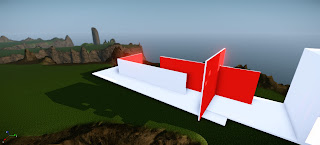To develop my bridge I first used an existing plan as a precedent for the section of my final design. I decision to use the plan for the Brick Country House by Mies Van Der Rohe was influenced by my architectural theory about new and upcoming technologies being the gateway to a new era of architecture, which I see being reflected in the interesting orthogonal geometries drawn out in the plan. After selecting this plan I began experimenting.
 |
| Brick Country House by Mies Van der Rohe |
In this process I utilised tracing paper to a great extent in order to manipulate the plan and help me brainstorm ideas.
I began by using tracing paper to trace the thick, heavy walls in the Country House and then rotated and overlaid the trace onto the plan, resulting in the above abstract bridge design. I'm drawn to the rotational symmetry of the above design as it naturally allows for spaces for students, teachers and combined spaces for both.
I then traced over the entire section and began imagining where the various rooms would be located. At this stage I decided to keep my design relatively rigid to the original floor plan, in order to have a grounded platform which I can extrapolate and experiment from.
Still keeping to the original plan, I looked at how this design would look in a more bridge-like form. I played with the idea of an abstracted cable-stayed bridge, a school of architecture suspended in the air by mere strings.
From here I began manipulating the design, stretching and elongating it to be more bridge-like. At this point I realised the modular, mis-matched blocky shaped don't really look that integrated into the bridge.
From here I started streamlining the design which helped it to integrate better into the bridge. While I see this as an improvement, I realised that I lost the rotational symmetry aspect of the design.
I streamlined even further here, largely moving away from orthogonality and going towards a sleeker, more angular design. I feel this better represents rotational symmetry and the angles abstractly represent circuitry and the transfer of information.
Settling on this design I drew a section of it in sketchup.
From here I extruded it into three dimensions and added the cables.
I settled on this design because it's angular nature and symmetric qualities allow for vastly different views of the valley depending on where you are. On the upper levels you would see the surrounding mountain ranges and the sky whereas on the lower levels you would see the bottom of the valley, the river, and the underside of the bridge, showing you what little there is preventing you from plummeting to the ground.
Over the next few weeks I will detail the rooms of the school and further refine my design.




















































